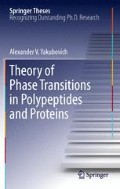Abstract
A protein is a polypeptide chain consisting of a sequence of units or “residues”, which are amino acids chosen from a pool of 20. Proteins are synthesized as unfolded polypeptide chains and they fold after synthesis in order to become active.
Access this chapter
Tax calculation will be finalised at checkout
Purchases are for personal use only
References
Anfinsen, C. (1973). Principles that govern the folding of protein chains. Science, 181, 223–230.
Banavar, J., & Maritan, A. (2007). Physics of proteins. Annual Review of Biophysics & Biomolecular Structure, 36, 261–280.
Protein data bank. (2010). http://www.rcsb.org
Floudas, C., Fung, H., McAllister, S., Monnigmann, M., & Rajgaria, R. (2006). Advances in protein structure prediction and de novo protein design: a review. Chemical Engineering Science, 61, 966–988.
Crick, F. (1988). What mad pursuit: a personal view of science. New York: Basic Books.
Boczko, E., & Brooks, C. (1995). First-principles calculation of the folding free-energy of a 3-helix bundle protein. Science 296, 393–396.
Camacho, C., & Thirumalai, D. (1993). Kinetics and thermodynamics of folding in model proteins. Proceedings of the national academy of sciences of the United States of America 90, 6369–6372.
Garcia, A., & Onuchic, J. (2003). Folding a protein in a computer: an atomic description of the folding/unfolding of protein. Proceedings of the national academy of sciences of the United States of America, 100, 13898–13903.
Pande, V., Baker, I., Chapman, J., Elmer, S., & Khalig, S. (2003). Atomistic protein folding simulations on the submillisecond time scale using worldwide distributed computing. Biopolymers 68, 91–109.
Alm, E., & Baker, D. (1999). Physics of proteins. Proceedings of the national academy of sciences of the United States of America, 96, 11305–11310.
Henry, E., & Eaton, W. (2004). Combinatorial modeling of protein folding kinetics: free energy profiles and rates. Chemical Physics, 307, 163–185.
Munoz, V. (2002). Thermodynamics and kinetics of downhill protein folding investigated with a simple statistical mechanical model. International Journal of Quantum Chemistry, 90, 1522–1528.
Muñoz, V. (2007). Conformational dynamics and ensembles in protein folding. Annual Review of Biophysics & Biomolecular Structure, 36, 395–412.
Yakubovich A., Solov’yov I., Solov’yov A., & Greiner W. (2006). Conformational changes in glycine tri- and hexapeptide. The European Physical Journal D, 39, 23–34.
Yakubovich, A., Solov’yov, I., Solov’yov, A., & Greiner, W. (2006). Conformations of glycine polypeptides. Khimicheskaya Fizika (Chemical Physics), 25, 11–23(in Russian).
Solov’yov, I., Yakubovich, A., Solov’yov, A., & Greiner, W. (2006). On the fragmentation of biomolecules: fragmentation of alanine dipeptide along the polypeptide chain. The Journal of Experimental and Theoretical Physics, 103, 463–471.
Solov’yov, I., Yakubovich, A., Solov’yov, A., & Greiner, W. (2006). Ab initio study of alanine polypeptide chain twisting. Physical Review E, 73(1–10), 021916.
Solov’yov, I., Yakubovich, A., Solov’yov, A., & Greiner, A. (2006). Potential energy surface for alanine polypeptide chains. Journal of Experimental and Theoretical Physics, 102, 314–326.
Yakubovich, A., Solov’yov, I., Solov’yov, A., & Greiner, W. (2006). Phase transition in polypeptides: a step towards the understanding of protein folding. European Physical Journal D, 40, 363–367.
Yakubovich, A., Solov’yov, I., Solov’yov, A., & Greiner, W. (2007). Ab initio description of phase transitions in finite bio- nano-systems. Europhysics News, 38, 10–10.
Andersen, L., & Bochenkova, A. (2009). The photophysics of isolated protein chromophores. European Physical Journal D, 51, 5–14.
Shintake, T. (2008). Possibility of single biomolecule imaging with coherent amplification of weak scattering x-ray photons. Physical Review A, 78(1–9), 041906.
Pazera, T., & Sachs, A., (Eds.). (2009). DESY 2008. Wissenschaftlicher Jahresbericht des Forschungszentrums DESY. Deutsches Elektrinen-Synchrotron DESY.
Solov’yov, I., Yakubovich, A., Solov’yov, A., & Greiner, W. (2008) \(\alpha\)-helix\(\leftrightarrow\)random coil phase transition: analysis of ab initio theory predictions. European Physical Journal D, 46, 227–240.
Yakubovich, A., Solov’yov, I., Solov’yov, A., & Greiner, W. (2008). Phase transitions in polypeptides: analysis of energy fluctuations. European Physical Journal D, 51, 25–31.
Yakubovich, A., Solov’yov, A., & Greiner, W. (2010). Conformational changes in polypeptides and proteins. International Journal of Quantum Chemistry, 110, 257–269.
Yakubovich, A., Solov’yov, A., & Greiner, W. (2009). Statistical mechanics model for protein folding. AIP Conference Proceedings, 1197, 186–200.
Author information
Authors and Affiliations
Corresponding author
Rights and permissions
Copyright information
© 2011 Springer-Verlag Berlin Heidelberg
About this chapter
Cite this chapter
Yakubovich, A.V. (2011). Introduction. In: Theory of Phase Transitions in Polypeptides and Proteins. Springer Theses. Springer, Berlin, Heidelberg. https://doi.org/10.1007/978-3-642-22592-5_1
Download citation
DOI: https://doi.org/10.1007/978-3-642-22592-5_1
Published:
Publisher Name: Springer, Berlin, Heidelberg
Print ISBN: 978-3-642-22591-8
Online ISBN: 978-3-642-22592-5
eBook Packages: Physics and AstronomyPhysics and Astronomy (R0)

